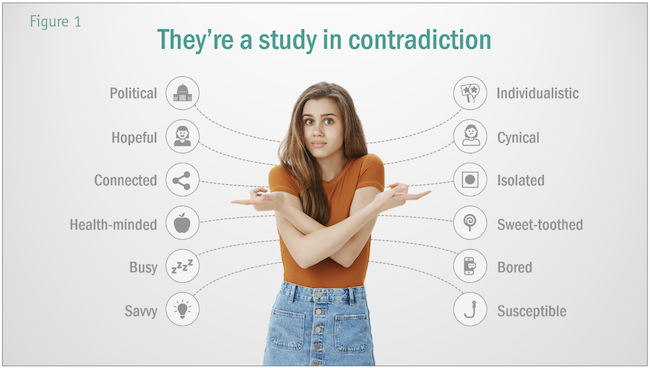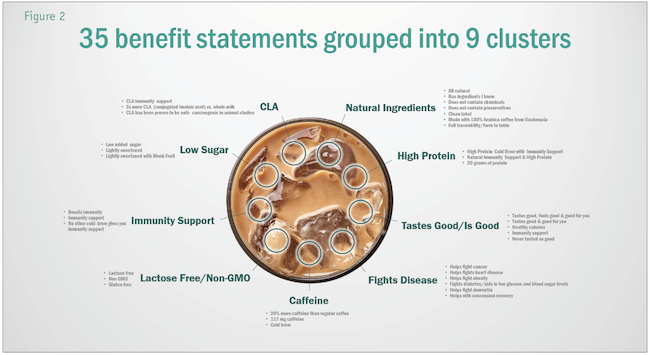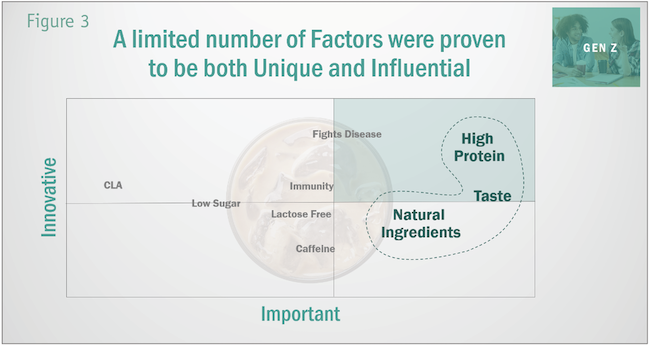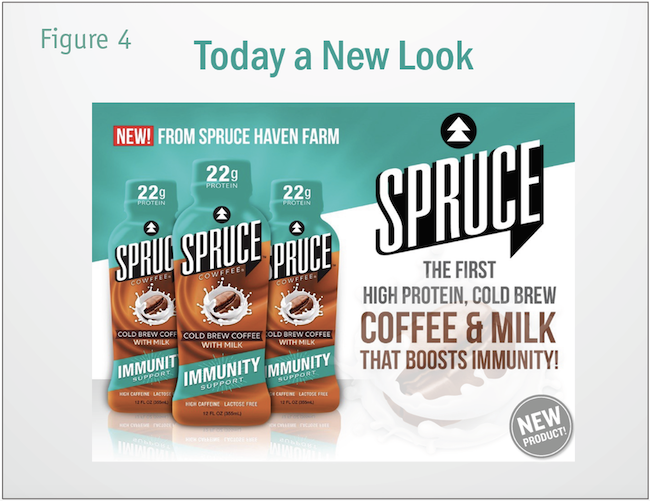Maintaining a buzz
Elliot Savitzky is senior vice president at TRC Market Research. He can be reached at esavitzky@trcmarketresearch.com. Hannah Robbins served as fractional CMO for Spruce Haven Farms at the time of the project profiled in this article. She can be reached at hannahrobbins13@gmail.com.
Last issue, in part one of this article (“Creating a buzz”), we described the challenges we faced in creating a go-to-market (GTM) strategy for Spruce Cowffee, a better-for-you cold brew coffee from New York-based Spruce Haven Farms.
Having identified target markets and selecting packaging and a preferred name, we needed to confirm the product’s appeal, create a leverageable positioning for the brand and gear it up for success. Specifically, with whom is Spruce most likely going to compete and how will the product differentiate itself in an already crowded market?
We tested the idea of cold brew coffee with over 1,200 geographically dispersed Gen Zs and Millennials and were astonished to find that 70%-80% of these two groups already drank cold brew coffee at least once a week. We then showed them a description of what Spruce was all about and an unprecedented 60%+ of them indicated they would either definitely or probably buy it in the future. We don’t regularly see numbers as high as these, particularly among a group of consumers who have such strong opinions about what they put in their bodies.
We then asked them to tell us in their own words why they liked Spruce so much and if they would recommend it to their friends. What we found was eye-opening: with no previous knowledge of the product or the brand, and with only a brief description of the basic premise of the idea, these consumers understood the benefits of the product, internalized them and played them back to us in way that led us to believe they were convinced that this was a product for them. Thus the brand/concept clearly resonates when the audience understands product attributes and benefits, which further supports the critical value of brand appeal to the right target market.
“It has all of the good things for you and none of the bad things. It helps give me energy when I need to get up and go to work. It helps give me energy when I get home from work.”
“I don’t think I’ve heard of a coffee that gives you so much support for your body, your mind and your well-being as Spruce Cold Brew. It has the added benefit of having a ready to go, ‘grippable’ container which is recyclable and with eco-friendly ingredients that can be traced back to the very udder of the cow.”
“This is something that can be consumed on a daily basis or as a treat that can also be beneficial to your health, which is always fun when you can pair good behaviors with good consequences.”
Understanding attitudes and beliefs
Consumers don’t just purchase brands; they buy with emotions, hopes and fears. Their wallet represents an inner narrative and each brand’s ability to effectively inspire and ignite an emotional connection is how the path to profitability is won. We asked this target audience questions about their attitudes, lifestyles and psychographics and we were surprised at what we found. Instead of being consistent in their attitudes and behaviors, these consumers were a contradiction in terms, claiming, for example, a strong interest in healthy eating while also confessing to having a sweet tooth or being hopeful for the future at the same time as they expressed cynical views of our current world.
When consumers are pondering a decision it usually suggests that there is some type of internal conflict going on. This inner turmoil is known as cognitive dissonance. “Cognitive dissonance theory postulates that an underlying psychological tension is created when an individual’s behavior is inconsistent with his or her thoughts and beliefs. This underlying tension then motivates an individual to make an attitude change that would produce consistency between thoughts and behaviors.”1
Much of our qualitative research touches on consumers dealing with internal conflicts and our approach helped inform us on how best to address these inner narrative conflicts for positioning the brand to the target market. These contradictions between a closely held value and a course of action may get in the way of making decisions, important or otherwise.
In this case, we concluded that Spruce talked directly to most of consumers’ conflicts. It provides a much sought-after alternative with its physical and emotionally healthy benefits. It boosts immunity. It has the caffeine to keep the consumer going. It is lightly sweetened and tastes great. It is a sustainable product that gives back to the community. It provides the convenience of on-the-go, ready-to-drink packaging. It also has a good shelf life. And, finally, it’s not only real but it’s really simple. The brand promise delivers key pillars this generation values: knowing the exact food source along with high nutritional benefits.
Standing out in a competitive market
Every product faces some kind of competition but Spruce was up against a behemoth – Starbucks – and a host of many other smaller, regional brands. So how do you compete in a market like that? The last cog in the brand positioning machine is determining your key points of difference (KPDs) and which ones matter most to the identified target market. What is important to your target consumers?
We can already hypothesize some of the key benefits that will appeal but there were so many of them that we needed some way to understand where to focus. Do we talk about taste? Healthfulness? The high-quality ingredients?
The first step was to convince the client that they had too many benefits to start with. In part one of this article we explored how stakeholder bias impacted everything from potential product names to the primary target market and here again it was a barrier to streamlining the benefit selection process – something we find prevalent with so many brands.

We started with about 120 benefits that the client wanted to include in our research. We narrowed them down to 35 statements that could be logically grouped into nine clusters (Figure 2). The package is a brand’s prominent and most important advertising tool so every word and graphic matters. In Spruce’s case there were way too many to put on a package let alone promote in any marketing communications.
So how do we determine which KPDs to include? TRC has created a methodology called Two-Dimensional Max-Diff (2DMD) that aims to add value to an already powerful tool. It allows us to assess choices on two dimensions at the same time. Whereas the standard MaxDiff technique may ask participants to identify which of a selection of four items are most and least important in their decision to purchase a product, 2DMD can assess those same items on two dimensions at the same time (“most important” and “most unique,” as an example) and that is the technique we used to assess these 35 statements for both importance and innovation.
Rather than take a consumer through two separate evaluations on two separate dimensions, this technique avoids the added confusion and fatigue and kills two birds with one stone. Hence, we rated four of the 35 benefits at random on what was most important in their decision to purchase Spruce in the future and what was the most innovative of the four options they considered.

Consumers’ cognitive ability to understand and rationalize a product’s benefits is often limited to no more than two or three KPDs or key selling points. With the goal of maximizing Spruce’s benefit-messaging, the results were clear to us: the 35 items clustered into nine key areas that made logical sense to the target audience. The upper-right quadrant of the map (Figure 3) represents the items that were most important and most innovative: protein, taste and natural ingredients. Taste/flavor is always paramount in the beverage segment and therefore adding protein and natural ingredients as the top-two ranking factors gave the client direction and very actionable next steps.
Not relying on ‘gut feeling’
Rather than “gut feeling,” we used research to identify a name, winning packaging, a clear target market, the competitive frame and the KPDs. The next step was for the client team to incorporate all the rich data and insights into a strategically sound brand launch and a new look for the packaging (Figure 4) with all the important stuff on the front panel.

We have our value proposition, we have our go-to-market strategy and now it's time to deliver channel-specific proofs of concept. Once we identify the most efficient retail segments to target – traditional grocery, clubs, convenience stores, natural food stores, mass merchandisers, etc. – we have a fantastic value proposition with which to move forward.
While the success of this new strategy is yet to be determined, we do know that the path to profitability starts with converting strategic insights into action. Using effective research methodologies, the brand completely pivoted from its beginnings and is well-positioned for launch, with an innovative, healthful and great-tasting product.
References
1 J.K. Thompson, ... J.E. Menzel, in “Encyclopedia of Body Image and Human Appearance,” 2012.
